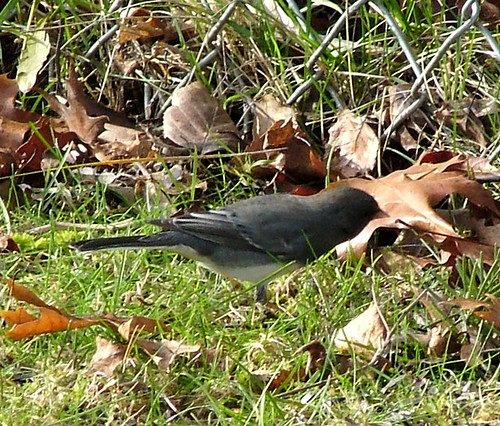
We’ve had so much good weather lately, we humans can practically ignore the change in seasons—but the birds on the Hill are getting ready for winter. The swallows and many of the warblers are leaving town. Meanwhile, the local population of dark-eyed juncos is growing fast.
There are five broad subspecies of dark-eyed juncos in the United States. Here in Capitol Hill, our juncos almost all belong to the Oregon subspecies: pretty little birds with black hoods and brown backs. A second subspecies, the slate-colored dark-eyed junco, also occurs in Western Washington, so it’s worth keeping a lookout for them, too. Juncos flock together with little regard for feather, so you may glimpse a slate-colored—which has striking black and white plumage—mixed in with a flock of Oregons.
Dark-eyed juncos’ migratory patterns vary by population and subspecies. Many juncos, including some here Western Washington, stay in one area year-round. Of those that do migrate, many follow a north-south route, traveling from summer nesting sites in Canada down to winter feeding sites here in the United States. Other juncos are altitudinal migrants, spending summers in mountainous regions and winters in low-lying areas.
Juncos that migrate sometimes travel different distances depending on their sex and age. Females usually travel farther than males, and older birds may travel farther than younger birds. The best explanation for this phenomenon is that males, which are territorial during the breeding season, need to get to the breeding grounds quickly to establish a mating site in spring. However, older birds are more dominant and perhaps less strongly affected by this requirement. Meanwhile, females can enjoy better feeding grounds farther away and then return to the breeding sites a little later.
If you want to see a dark-eyed junco, look for flocks of small birds on the ground or in low-lying bushes. If you spook a group, don’t despair. All subspecies of juncos have broad white stripes on either side of the tail. You can often get a good look at this field mark even when the juncos are making a hasty retreat.
Want to learn more?
- Check out the dark-eyed junco page at the Cornell Lab of Ornithology.
- Hear this bird’s song and call at the Macaulay Library of Natural Sounds.
Because of plumage variability, the species currently called “dark-eyed junco” was classified as five distinct species until the 1970s, when biologists learned the details of their genetic makeup and lumped them into a single species group. If you’d like to read more about this (or pretty much anything else about birds), try visiting The Birds of North America Online. Note that you’ll be asked to buy a subscription if you want more than the basic introductory info. However, you can access the site free through the Seattle Public Library if you have an active library card number and PIN.
Melissa Koosmann is a freelance writer and resident of Capitol Hill. She writes about education, culture, gardening and nature — and, sometimes, birds for CHS.




Thanks for enlightening me about another hill inhabitant. I’ll keep my eyes open!
Lots of birds on our balcony bird feeder. Some quality feed from Wild Birds Unlimited seems to do the trick, Another key trick is providing water for our feathered friends. With this string of dry weather, a good supply of clean fresh water is also important.
Especially in winter, I’ve noticed these little guys show up at my bird feeder… I’ve seen them even in the snow…nice to know a little bit more about my visitors.
Not surprised you’ve seen them in snow. In some areas, they’re commonly called “snowbirds.”
Thanks for the funny & informative blog this month!
No problem. Thanks for stopping by.